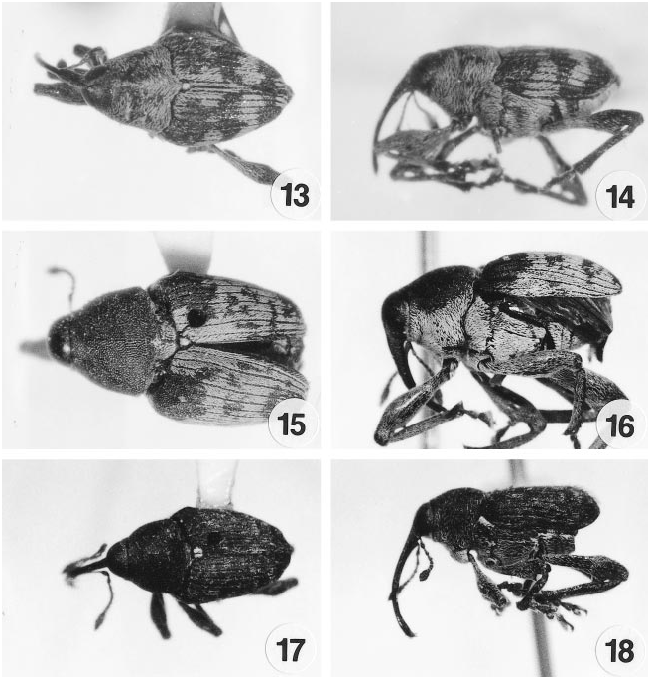Curculio shopfneri Pelsue and Zhang
|
publication ID |
https://doi.org/10.1649/0010-065x(2000)054[0467:arotcf]2.0.co;2 |
|
DOI |
https://doi.org/10.5281/zenodo.15700368 |
|
persistent identifier |
https://treatment.plazi.org/id/8C170A27-B60D-9472-FEAE-A714FECBFB91 |
|
treatment provided by |
Carolina |
|
scientific name |
Curculio shopfneri Pelsue and Zhang |
| status |
sp. nov. |
Curculio shopfneri Pelsue and Zhang View in CoL , New Species
Figs. 17–18 View Figs , 57–58 View Figs
HOLOTYPE. China. Emei Shan: Male [China/ Sichuan /Emei Shan/800–1,000 M/ 23 May 1957 / K. Huang] ( IZAS)
PARATYPE. (1) China. Male [China/ Beijing / Baihuashan / 19 June 1951 / IZAS] ( FWPC)
Recognition Characters. Mediumsized to large, elongate, oval, moderately robust; derm uniformly piceous; rostrum, 0.58 as long as body; frons, 0.27 as broad as head across eyes; hind femoral tooth mediumsized, thorn shaped; hind femur lacks proximolateral sulcus; vestiture primarily of narrow, elongate, testaceous, with a large number of white, bifid scales mixed; mesepimeron, with dorsal fringe of white scales; scutellum white, as long as broad.
Male: Length: 5.2 mm. Width: 2.7 mm. Head: Mediumsized, moderately convex; punctures small, clothed with fine, narrow, elongate, semierect, setalike scales; ventral macula of narrow, clavate, cretaceous scales, beneath eyes; eyes large, oval, finely faceted; frons broad, 0.27 as broad as head across eyes; shallow slitlike interocular fovea, with small punctures. Rostrum: Length: 3.0 mm; 0.58 as long as body; cylindrical, thick at base, gradually tapering to apex; margins subparallel to antennal insertion becoming narrower, then expanding slightly before apex; feebly straight to antennal insertion, then curving feebly to apex; median dorsal carina from frons to antennal insertion; punctures large, oval, deep, finer after antennal insertion to apex; base with fine narrow, elongate, semierect, dirty, white setalike scales; scrobe ventral; scape inserted in apical half. Antennae: Length of scape 1.3 mm; Funiculus: segment one 0.3 mm, two 0.25 mm, three 0.25 mm, four 0.1 mm, five 0.1 mm, six 0.1 mm, seven 0.125 mm, club 0.6 mm; funicle 1.825 mm; scape 0.72 as long as funicle; vestiture of dense narrow, elongate, white scales, with numerous erect setalike scales; club elongate, oval, acuminate, vestiture of fine, velvety pile, with few erect setae; club longer than segments 4–7. Thorax: Length: 1.5 mm. Width: 2.0 mm. 0.75 as long as broad; margins subparallel, broadly rounded to constriction; disc moderately convex in lateral view; disc with feeble indication of median carina; punctures small with short, erect, narrow, elongate, testaceous scales; base sinuate, with median declivity; mesosternal intercoxal process prominent, clothed with narrow, elongate, white scales; scutellum medium, convex, as long as broad, vestiture white, divided medially; anteroventral macula of narrow, elongate, bifid, dirty, white scales; some narrow, elongate, bifid, white scales on pleuron; mesepimeron with dorsal fringe of long, narrow, bifid, white scales; mesepisternum sparsely clothed with long, narrow, bifid, white scales; metepisternum with narrow, elongate, white scales, with acute apices; procoxae clothed with narrow, elongate, bifid, white scales. Elytra: Length: 3.0 mm; wider than base of pronotum; base sinuate; striae prominent with deep punctures and narrow, elongate, white scales; humeri prominent with shallow posterior declivity; intervals flat, broad, clothed with short, narrow, testaceous scales and scattered longer, narrow, white scales, with acute apices; crosshatched setae erect, long and piceous. Legs: Length of hind femur 2.5 mm, tooth mediumsized, thorn shaped; tooth small on pro and mesofemur; hind femur lacking proximolateral sulcus; vestiture of all femora of narrow, elongate, white scales, with some testaceous scales mixed, all with acute apices; pro and mesouncus large, as long or longer than tarsal claw; metauncus bifid. Abdomen: Sternite 1 longer than 2 behind coxal cavity, with broad, shallow, median declivity; sternite 2 ascending to 3; sternite 3 slightly longer than 4; sternite 5 not as long as 3 and 4 combined, with emarginate apex; vestiture of all sternites similar, with narrow, elongate, bifid, white scales, with sternites 1 and 2 having a narrow lateral macula of broader, elongate, dirty white scales. Pygidium: Small , clothed with short, white, setalike scales. Genitalia: Median lobe of aedeagus 1.3 mm in length, 0.25 mm in width; sides narrow, evenly tapered to gradual arc to rounded apex, rather thin and flat in lateral view; apodeme 1.2 mm in length ( Figs. 57–58 View Figs ).
Distribution. China: Sichuan Province, Emei Shan, 800–1,000 M, 23 May 1957, K. Huang; Baihuashan Province, Beijing, 19 June 1951, IZAS.
Remarks. This species is close to C. tonkeninsis , but can be separated by white macula on mesepimeron, white bifid scutellum, shorter rostrum and male genitalia. It is named in honor of the senior author’s good friends the Charles Shopfner family.
| IZAS |
Institut Zoologii Akademii Nauk Ukraini - Institute of Zoology of the Academy of Sciences of Ukraine |
No known copyright restrictions apply. See Agosti, D., Egloff, W., 2009. Taxonomic information exchange and copyright: the Plazi approach. BMC Research Notes 2009, 2:53 for further explanation.
|
Kingdom |
|
|
Phylum |
|
|
Class |
|
|
Order |
|
|
Family |
|
|
Genus |


